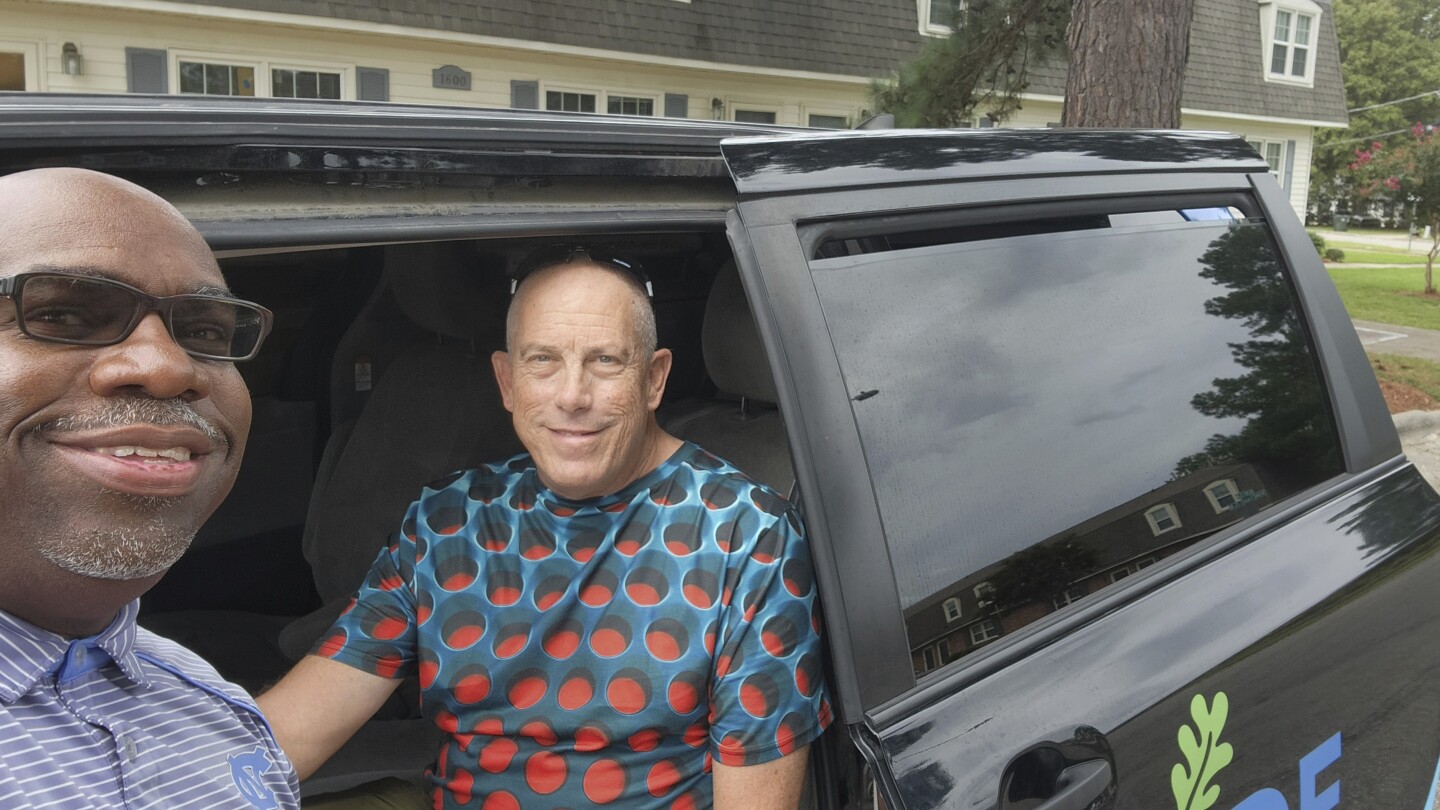What if public transit was like Uber? A small city ended its bus service to find out::Small-scale, tech-based solutions to transportation problems have emerged as a great equalizer in the battle for infrastructure dollars between big cities and rural communities.
Americans will do anything but build consistent public transport.
…Without any actual public transportation
What makes this a bad idea? Sounds much better than busses to me. It’s on demand, not on a fixed route, gors anywhere in the town, and is still the price of a bus ride.
It doesn’t reduce the number of cars on the road. If anything, it increases it because they got rid of buses.
I see, yes that’s a good point, but I’d guess that’s not the goal of this program. Not sure if that’s a goal of any transportation agency, at least not that I’ve heard, but it should be.
Yeah, but busses actually consume quite a bit of fuel versus a smaller passenger vehicle, and in smaller towns running a regular bus that doesn’t have many or even any passengers might still be less environmentally sound, especially if they use an EV and charge between call-outs.
Even in my home town which is of decent size, the bus routes are super inefficient time-wise as they require a stop and transfer at the central station (making a trip take 1-2 hours) whereas taking the direct route up the highway is maybe 15m
Trolley buses are great, look them up.
Yeah I’m aware of trolley buses. Again, running the infrastructure for this versus independent electric vehicles for smaller populations or low-use areas doesn’t necessarily make sense
Yeah… except, if a city hasn’t been designed around supporting a trolly system, you’re not getting a trolly bus any time soon. You’re looking at years, potentially over a decade of work.
Removed by mod
There are a lot of places in America where public transit in the form of regular bus routes isn’t really workable. And like it or not, cities were built without public transit in mind: neighbourhoods are not dense and built around trunk routes. Step one to catch a bus is often “walk 15 minutes to the bus stop”. And often there’s not even sidewalks. This is…unavoidable, you can’t rebuild entire cities or have 5x as many bus routes. It’s unfortunate, but it’s reality.
If you could get a tech company or startup to provide the mapping/routing software, it would be feasible to make “Uber-style” buses that generated routes on the fly, based on user-requested start & stop locations.
Famously (within logistic circles, anyway) Amazon FCs (basically warehouses, but with minimum capacity) store all their stock randomly. People unload incoming boxes and literally toss them randomly on the shelves wherever they fit–but only after scanning the product and the shelf it’s on. Then, when you buy something on Amazon, the inventory system finds a ‘picker’ (somebody taking things off the shelf) who’s near the desired product…they grab it and toss it in a crate on a conveyor belt, which is then routed to a packer, who packs it together with everything else headed to the same customer.
This works much better than traditional warehouses where bulk inventory is all stored together in great big bins. It’s one of the big things that makes Amazon so hard to beat on shipping speed & price.
So, analogously: have small buses (not Ubers, with one customer per vehicle) which drive though neighbourhoods, picking up people at or near their house, and dropping them off at Park & Rides, or transit centres, or light-rail stops, as well as destinations. If, at any given time, a bunch of people are headed to a particular spot, make an impromptu route and get 'em there. If things are busy, pay more to cause more buses to run.
This could work. And critically, it could work in American cities today, in a way buses just can’t. And it could drive people to public transit, thus increasing demand and revenue, allowing it to expand.
you know, you could literally have more bus stops? you could also have a network instead of a trunk
As I said in another reply, a one-way trip to the downtown area of my nearest city is a 1.5-2 hour trip, making for a 3-4 hour round trip commute. This is because the first bus I’d have to catch meanders through the suburb, stopping often, because that’s the only way to provide service to giant spread-out suburbs. Either that, or you’d need like 3-4x as many buses cruising through neighbourhoods that were not designed to accommodate buses. And that’s not remotely politically viable.
The bus I would catch is usually mostly empty. People don’t bother walking anywhere from 5 - 30 minutes to the bus stop to take a 45 minute bus ride to a place that would’ve been a <15 minute car ride away. And they do have a car, there’d be no realistic way to live in a suburb without one. And most people live in a suburb.
Frankly, typical American suburbs aren’t really dense enough to support bus routes. That’s why it seems to me that something like this could work. Dynamic bus routes that come closer to your actual home and take you to a trunk route in a reasonable time would be very handy.
I live in Italy. Most of our cities are at least one millennia older than yours. I live in a small town in the middle of nowhere and it’s still a few centuries older than the USA as a whole.
Our cities were definitely not designed with public transit in mind, yet we have a somewhat consistent public transit everywhere (although it could definitely be improved in lots of places, including my town). For example: excluding a small car trip to the nearest train station, I travel to my work place (in Milan) exclusively with public transport.
Why can’t US cities do the same?
I mean you kind of answered your own question. Italian cities (and most European cities) are generally a millenia older than American cities. They were built around foot traffic. They’re dense. Stick a few strategic bus routes on major roads, and you’re covering a large amount of the population.
I think to understand the problem American cities face, Europeans would have to go for a stroll in a typical American suburb. I live a 30-40 minute walk from the nearest business of any kind (a grocery store). And I’m at the entrance of my neighbourhood; people living further in might easily be an hour’s walk away. The nearest office building is a couple hour’s walk (on a narrow sidewalk, next to a major road) A one-way commute to downtown (where the jobs are) is 1.5-2 hours for me, meaning 3-4 hours of commuting a day. Again: add 20-30 minutes for many of my fellow residents. Meanwhile, it’s a 15 minute drive (without traffic, anyway).
Then you’ve got the political problem. Since transit is pretty useless now, it’s really unpopular. Adding new routes helps only a relatively small number of people who live close to those routes. During the pandemic, many bus routes were shut down, and they haven’t come back.
So yeah, you can drive to a Park & Ride. People do that, they get very busy. But in my case, that involves driving roughly half the distance to downtown, at which point…catching transit feels like a token gesture. That kind of situation is pretty typical.
American cities were built around cars.

The picture understates it. You’ve also got to consider that the road on the left could be half as wide, and that the situation on the right requires a massive parking deck just off-screen that the one on the left doesn’t need.
Destroying walkability by physically forcing destinations further apart in order to insert more lanes and parking in between is what makes designing for cars a disastrous vicious cycle.
Because you don’t need a car to get that last mile. A much better and more flexible option woykd be robust trains/trams/subway system in dense cities that take you most of the way with electric options such as e-bikes or scooters to get you thay last bit if you need it. This does nothing but keeps our society dependant on car manufacturers and litters the road with more cars.
Did you read the article? This is a tiny sprawling city of 50k residents, and there simply wasn’t enough population density to justify most of the bus routes they were operating. I live in Europe and love the public transport here, but it’s possible that for extremely low density areas a scheme like this makes sense. Possibly combined with normal public transit along trunk routes
with electric options such as e-bikes or scooters to get you thay last bit if you need it.
Hi! I’d like to introduce you to winter. It destroys this as a workable solution, because for multiple months of the year it’s impossible for these to run. Meaning they’d need a last mile winter solution, such as… a car.
There’s also the issue of these types of solutions being notoriously hard to maintain. I believe the majority of city “e-thing” companies have gone under because it’s an unworkable system.
Take a normal bike. Finnland is able to support this.
Hi! I’d like to introduce you to winter. It destroys this as a workable solution, because for multiple months of the year it’s impossible for these to run. Meaning they’d need a last mile winter solution, such as… a car.
E-bikes, scooters, bicycles and public transit works in winter, just so long as you maintain the infrastructure they need.
Additionally, any claims that this would not be workable from a cost perspective is false, as winter maintenance is 100% required for car infrastructure, and winter maintenance for car infrastructure keeps on happening year after year.
There’s also the issue of these types of solutions being notoriously hard to maintain. I believe the majority of city “e-thing” companies have gone under because it’s an unworkable system.
Completely unsubstantiated.
Ok, I’m curious. I started using scooters this year, and every scooter I’ve seen says not to use below certain temps (-10C or so).
Naturally, you should follow whatever specifications come with your scooter, but this is partly up to engineering specifications and partly up to local winter weather.
My point was primarily about that snow and ice does not inherently render bicycles and scooters unusable, it’s a matter of actually maintaining their infrastructure.
I’m talking about temperature, not snow and ice. Most batteries aren’t rated for temps in the far negatives, and the northern states routinely see -40 degree temps.
Hi! I’d like to introduce you to winter. It destroys this as a workable solution
There are places that have on demand busses rather than fixed routes.
Short gain compared to long term investment right here.
This is akin to discovering that you can hire freelance developers from developing nations for 1/10 of the cost, but then after 3 years… your whole system is a spaghetti mess and the rebuild cost many times that.
Because they’re now having to switch back over to buses anyways.
I think on-demand transit makes sense in many areas but for a town of this size, it seems like it would be better as a supplement to a traditional bus system than a full replacement. 50,000 is not exactly rural though I’m not sure what the density looks like.
I think 50k is definitely on the low end of what you might consider a “city”. And you’re right, it would depend on density. IMO a city with that population can’t really sustain a bus system if it’s spread out too much.
I lived in a town with 50k back in the 90s. I don’t remember there ever being a bus service except for the school buses.
The town was pretty massive though. Half the town was on a plateau as well so you had to walk up a pretty huge hill to get to half of it.
There was quite a few taxi’s driving people around.
Maybe there was a bus that I never used and can’t remember. As a kid I rode everywhere. That hill was a son of a bitch though.
Pro-move: hire even more contractors to refactor.
This isn’t a solution. This is a small city making a choice that’s hostile to the environment and, if anything, intentionally laying the groundwork to privatize the local public transit options to invite surge pricing and other unethical price gouging that have no place in public services.
LA Metro is doing a similar service as an additional option with their transit. It’s designed as an option to fill in the gaps. More need to look to LA Metro. They’re doing a lot right.
Long wait times made the bus route almost unusable for David Bunn, even when his car broke down and he couldn’t afford to replace it. Instead, Bunn, who has two broken discs in his back, would take a 5-mile (8-kilometer) roundtrip walk to pick up groceries.
“A small city”
The city of less than 50,000 people
Very small, yes.
I dont know if you understand. In Europe if grocery shop isnt in your village, its probably 2-3km away in the neighboring village. Calling something “a city” indicates that everything is denser. So I find it funny when American “cities” are less dense than European “villages separated by farmland”
I’m European. Tiny cities exist here too. As do food deserts. When most people drive, local shops and bus services disappear, and people without cars get stranded.
The point of transit is not to have a bus. The point of transit is getting people where they need to be.
This is definition of transportation, not transit
as many as 3 in 10 residents lacked access to a car to get to work
Because people need a car to get from point A to point B. Enough of this bs. Stopped reading there
deleted by creator
i thought it waa somethings revolutionary, like, for ex, those who already have cars would pickup those without one, and get some gratification. Like we already have thousands of most-empty cars, let’s fill them up!
But no, they just have city-paid taxi lol huhu such revolution, much thought process, very innovative
This is the best summary I could come up with:
Milton Barnes used to oversee packed subway stations in Washington, D.C., a far cry from the sparsely filled buses he drove after moving to Wilson, North Carolina, to care for his elderly parents.
Wilson landed federal and state infrastructure grants to support the shared, public rides residents summon — usually within 15 minutes — through a service operating like Uber and Lyft, but at a fraction of the cost to riders.
These smaller-scale, tech-based solutions to public transportation problems, known broadly as microtransit, have emerged as a great equalizer in the battle for infrastructure dollars that has traditionally pit the bus, train and subway needs of urban areas against the road construction projects sought by rural communities.
Via started operations seven years earlier with what was then a consumer service offering shared van rides in parts of Manhattan’s Upper East Side where the New York City subway didn’t go.
Even Wilson won’t be able to operate under its microtransit pilot program forever without finding new ways to pay for it, said Kai Monast, associate director of the Institute for Transportation Research and Education at North Carolina State University.
Monast predicts that although Wilson will remain committed to microtransit, the community eventually will return in part to a fixed-route system, adjusted heavily from the data gathered through years of on-demand van rides.
The original article contains 1,146 words, the summary contains 221 words. Saved 81%. I’m a bot and I’m open source!
He got cool T-Shirt.
Reminds me of those rubber, neon-colored, palm-sized sports balls.
deleted by creator
Columbus Ohio does both that and buses. Unfortunately the area covered is much smaller than it ought to be
Wait what ?
I’m not sure how I feel about this. On one hand, access to transit is great. On the other hand, I feel like the greenhouse gas reductions would be minimal.
Seems like a really good solution for small cities
Imho a bit comparable to the tricycles, racals and jeepny’s in the Philippines tbh… It works, prices are cheaper than taxi’s, comfort goes down as cost, but at least many lowerclasses can get places without having to own a car…

















